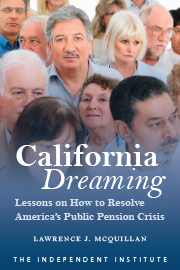“Smart growth” projects across the country aim to jam people into high-density housing near mass transit systems.
Proponents think this will make people abandon their automobiles, reducing greenhouse gas emissions. But new research shows “stack-and-pack” housing is an ineffective way to reduce carbon dioxide levels.
Researchers at the University of California Energy and Resources Group in Berkeley used Census, weather, economic and transportation data—37 variables in total—to estimate greenhouse gas emissions from the energy, transportation, food, goods and services consumed by U.S. households.
They calculated “household carbon footprints” for more than 31,000 U.S. ZIP codes (of approximately 43,000 total) in all 50 states and found that a “10-fold increase in population density in central cities yields only a 25% reduction in greenhouse gas emissions.”
In other words, the number of people living in cities such as Los Angeles, San Francisco, Chicago, Miami, Philadelphia and New York would have to increase 10 times—from 1.5 million in Philadelphia, for example, to 15 million—to yield a 25% reduction in CO2.
As the study’s co-author, Christopher Jones, put it: “(A 10-fold increase) would require a really extraordinary transformation for very little benefit.”
Stack-and-pack living is a blueprint for misery in urban America. Few people would want to live in such conditions. Yet this is exactly the vision that smart-growth advocates and their political allies are pushing.
For example, the regional smart-growth plan for the San Francisco Bay Area, approved last summer, calls for jamming an additional 2 million people into just 5% of the Bay Area’s land over the next 27 years.
Similar plans exist, or are being discussed, in metro Chicago, El Paso, Minneapolis-St. Paul and a seven-county area of South Florida—including Broward, Miami-Dade and Palm Beach counties—to name a few locations.
These regional government master plans effectively eliminate local control of communities. They also run into the Law of Unintended Consequences.
As politicians force urban centers to embrace more high-density housing, people who still want the American dream of a single-family home with a yard must move to the suburbs and commute farther.
As Jones, the UC Berkeley researcher, explained: “High-carbon suburbanization results as an unintended side effect.” Carbon emissions ripple out as dense suburbs emerge and, in turn, these suburbs spawn their own suburbs even farther out. The overall effect in large metropolitan areas is a net increase in total household carbon emissions.
And here lies the folly of government master plans to control growth. People are not chess pieces to be moved about at the will of politicians and bureaucrats. People have dreams and aspirations for themselves and their families.
Those dreams stand independent of planners’ preferences, and are often at odds with them. People still want single-family homes and are willing to drive long distances, if they must, to have them.
It would come as no surprise if smart-growth promoters next try to ban gasoline-powered automobiles or tax commutes beyond a certain radius. The end result of smart growth is greater political control over our daily lives.
The Berkeley study unintentionally offers strong support for the idea that local housing, transportation and land-use decisions should be made locally—not by regional governments, not in state capitals and certainly not in Washington.
CO2 emissions would fall in metro areas if people could get the housing they want close to where they work, not miles and miles away.
If governments ended their war on home construction, builders could buy the land they need to construct the housing that local people want, not housing that politicians and smart-growth activists want. That would increase the stock of affordable housing and help the environment too.









